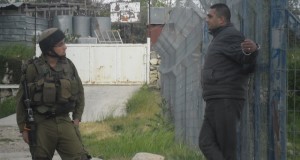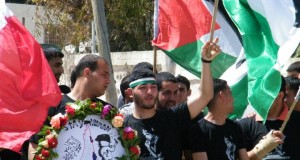by Mazin Qumsiyeh 16 April 2012 | Welcome to Palestine Campaign 2012 We did not have to show our 1500 visitors Israeli racism, arrogance, and human rights violations; the Israeli government showed them and also showed the whole world. Calling itself a ...
Read More »Author Archives: Yara
Increasing Israeli army harassment and violence against activists in Hebron
by Paige 16 April 2012 | International Solidarity Movement, West Bank In the past weeks the Israeli army has increased harassment against both Palestinian and ISM activists in Hebron (Al Khalil), a deliberate targeting of those who oppose Israeli occupation ...
Read More »Palestinians and internationals attacked during biking trip in Jordan Valley
by Joseph and Emiliano 15 April 2012 | International Solidarity Movement, West Bank Palestinian and international cyclists were brutally attacked by the Israeli occupation forces on Saturday as they attempted to bike up Route 90, the main North-South highway running ...
Read More »The price of intellectual resistance
by Sylvia 14 April 2012 | International Solidarity Movement, West Bank “Our souls are not devastated, we are hanging on” On the 7th November 2011, founder of the Palestinian Cultural Enlightenment (Tanwer) and lecturer at the An- Najah University, Dr. Yousef ...
Read More »Israel is paranoid about pro-Palestinian activists
by Gideon Levy 12 April 2012 | Haaretz Israel will not stand idly by as thousands of activists prepare to arrive on Sunday; it will not miss an opportunity to look ridiculous in the eyes of the world. And with ...
Read More »42 days of hunger strike: Take action to save Hassan Safady from dying in administrative detention
by Silvia and Andreas 13 April 2012 | International Solidarity Movement, West Bank Please SUBMIT pictures in solidarity with Hassan Safady FREE HASSAN SAFADY FREE ALL PRISONERS IN ADMINSTRATIVE DETENTION Today Hasan Safady entered into his 42nd day of hunger ...
Read More »Call for international action: Show your support on Palestinian Prisoners day
12 April 2012 | International Solidarity Movement This week International Solidarity Movement is calling for international solidarity in the run up to Palestinian Prisoners Day on the 17th April. The Palestinian prisoners struggle needs immediate international attention as Israel’s treatment ...
Read More »Israeli Border Police violently attack Palestinians and Intl’s in Hebron
by Abir Kopty 11 April 2012 | Popular Struggle Coordination Committee Twelve were detained and Three were injured after Israeli forces attacked participants of the Bili’n Conference on the Popular Struggle who toured Hebron. Israeli Border Police officers attacked a ...
Read More »Beit Hanoun remembers Vittorio: “When he spoke you had to listen”
by Nathan Stuckey 11 April 2012 | International Solidarity Movement, Gaza One year ago Vittorio Arrigoni was murdered. Since coming to Gaza, Vik, as everyone knew him, had been a regular at Beit Hanoun’s weekly demonstrations against the no go ...
Read More »Mahmoud, 19 years old, killed at Erez during Land Day between dreams and hopes: The words of his family
by Rosa Schiano 11 April 2012 | il Blog di Oliva On Friday 30th March, during the “Land Day,” Gaza joined the Global March in order to remember the confiscation of Palestinian lands by Israel which were protested against on ...
Read More » International Solidarity Movement Nonviolence. Justice. Freedom.
International Solidarity Movement Nonviolence. Justice. Freedom.








